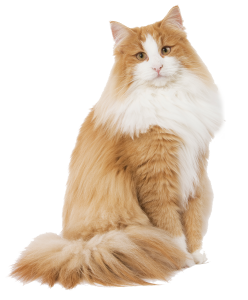Owners often struggle to assess their cat’s body condition. With feline obesity on the increase we are becoming used to seeing a slightly overweight profile as normal. Add to this the variation in body shape, whether a stocky British Shorthair or lean Siamese, and perhaps a longhaired coat, and it is not surprising that weight gain often goes unnoticed until a cat becomes obese. And at this point their health will be suffering, activity levels are reduced and weight loss can be a real challenge.

So you need to watch your cat’s weight to help keep them in the best shape. But do you simply put them on the scales? After all, this works for us, and many of us are tentatively standing on the bathroom scales at this time of year to see if we’ve put on any pounds over Christmas! In fact this is not particularly helpful for our cats.
The problem is that most owners don’t know precisely what their cat should weigh – a healthy weight for one cat may not be healthy for another. In fact, healthy adult weights can vary from as little as 2kg to 6kg or more depending on breed, type and size. And with these small numbers just a few 100g either way can make all the difference between a healthy weight and the beginnings of a weight problem.
To help combat this problem, vets and nurses use Body Condition Scoring all the time when assessing cats’ weight and there is no reason why you can’t learn to do it at home too.
- At ROYAL CANIN®, we recommend that a cat of an ideal weight will have a body condition score of 4 or 5 out of 9, when a 9 point scale is used.
- A score of 4 or 5 would be a cat with an obvious waist but with little abdominal fat. The ribs would not be that easily visible but you should be able to feel them straight away when you stroke your cat’s chest. Similarly, you should be able to feel the spine and hip bones but you made need to use a little more pressure to notice these.
- It is important that you don’t just look at your cat when you body condition score them, but that you also use palpation (touch), particularly in longhaired pets, as it can be easy to over or under-estimate their condition score if sight alone is used.
- Palpate your cat, without applying any pressure, over the ribs, spinal column, lumbar muscles and hips.
- On the 9 point scale, an overweight cat would be classed as a score of 6 or 7 out of 9. An obese cat would be an 8 or 9 out of 9.
If you think your cat has put on weight, why not body condition score them, to see how far they differ from their ideal? For a simplified, pictorial guide why not visit www.slimfitpet.co.uk and follow the ‘Check your Pet’ link?

If you have questions or concerns about your cat’s weight, speak to your vet or vet nurse. They will be more than happy to help you learn how to Body Condition Score your cat and, if your cat is overweight, they will be able to give you the right advice and support to ensure safe and healthy weight loss.